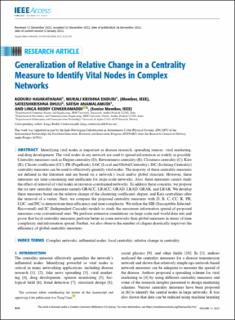| dc.contributor.author | Koduru, Hajarathaiah | |
| dc.contributor.author | Enduri, Murali Krishna | |
| dc.contributor.author | Dhuli, Sateeshkrishna | |
| dc.contributor.author | Anamalamudi, Satish | |
| dc.contributor.author | Cenkeramaddi, Linga Reddy | |
| dc.date.accessioned | 2023-05-23T08:46:53Z | |
| dc.date.available | 2023-05-23T08:46:53Z | |
| dc.date.created | 2023-01-07T12:24:28Z | |
| dc.date.issued | 2022 | |
| dc.identifier.citation | Koduru, H., Enduri, M. K., Dhuli, S., Anamalamudi, S. & Cenkeramaddi, L. R. (2022). Generalization of Relative Change in a Centrality Measure to Identify Vital Nodes in Complex Networks. IEEE Access, 11, 808-824. doi: | en_US |
| dc.identifier.issn | 2169-3536 | |
| dc.identifier.uri | https://hdl.handle.net/11250/3068623 | |
| dc.description.abstract | Identifying vital nodes is important in disease research, spreading rumors, viral marketing, and drug development. The vital nodes in any network are used to spread information as widely as possible. Centrality measures such as Degree centrality (D), Betweenness centrality (B), Closeness centrality (C), Katz (K), Cluster coefficient (CC), PR (PageRank), LGC (Local and Global Centrality), ISC (Isolating Centrality) centrality measures can be used to effectively quantify vital nodes. The majority of these centrality measures are defined in the literature and are based on a network’s local and/or global structure. However, these measures are time-consuming and inefficient for large-scale networks. Also, these measures cannot study the effect of removal of vital nodes in resource-constrained networks. To address these concerns, we propose the six new centrality measures namely GRACC, LRACC, GRAD, LRAD, GRAK, and LRAK. We develop these measures based on the relative change of the clustering coefficient, degree, and Katz centralities after the removal of a vertex. Next, we compare the proposed centrality measures with D, B, C, CC, K, PR, LGC, and ISC to demonstrate their efficiency and time complexity. We utilize the SIR (Susceptible-Infected-Recovered) and IC (Independent Cascade) models to study the maximum information spread of proposed measures over conventional ones. We perform extensive simulations on large-scale real-world data sets and prove that local centrality measures perform better in some networks than global measures in terms of time complexity and information spread. Further, we also observe the number of cliques drastically improves the efficiency of global centrality measures. | en_US |
| dc.language.iso | eng | en_US |
| dc.publisher | IEEE (Institute of Electrical and Electronics Engineers) | en_US |
| dc.rights | Navngivelse 4.0 Internasjonal | * |
| dc.rights.uri | http://creativecommons.org/licenses/by/4.0/deed.no | * |
| dc.title | Generalization of Relative Change in a Centrality Measure to Identify Vital Nodes in Complex Networks | en_US |
| dc.type | Peer reviewed | en_US |
| dc.type | Journal article | en_US |
| dc.description.version | publishedVersion | en_US |
| dc.rights.holder | © 2022 The Author(s) | en_US |
| dc.subject.nsi | VDP::Teknologi: 500 | en_US |
| dc.source.pagenumber | 808-824 | en_US |
| dc.source.volume | 11 | en_US |
| dc.source.journal | IEEE Access | en_US |
| dc.identifier.doi | 10.1109/ACCESS.2022.3232288 | |
| dc.identifier.cristin | 2102417 | |
| dc.relation.project | Norges forskningsråd: 287918 | en_US |
| cristin.qualitycode | 1 | |

